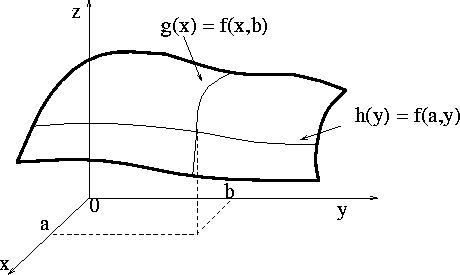|
We want to apply the concept of derivative to a function of several variables. Suppose f is a function of x and y.
If we let only x vary while keeping y=b fixed at the value b
we have a function of a single variable: |
> #
df f(a + t, b) - f(a, b)
---(a,b) = Limit ---------------------
dx t -> 0 t
| The partial derivative of f w.r.t. x can be seen as the rate of change of the value of the function with respect to a change in x when y is kept constant. If we visualize the graph of the function z = f(x,y) as a surface above the xy plane then the partial derivative of f w.r. to x at (a,b) is the slope of the line of intersection of the surface with the plane y=b at the point (a,b,f(a,b)). The following picture shows a surface z=f(x,y) and the graphs of the two curves z=g(x)=f(x,b) and z=h(y)=f(a,y), |

|
The slope of the tangent line to z=g(x) at x=a is the partial derivative of f w.r.t. x at (a,b) and the slope of the tangent
line to z=h(y) at y=b is the partial derivative of f w.r.t. y
at (a,b). To compute partial derivatives all you have to do is
to compute regular derivatives assuming all (but the variable
you are computing the derivative w.r.t.) the other variables
as if they were constants.
The following picture shows how the plane x=a cuts the surface z=f(x,y) in full animation,
Here are several examples with maple: |
> f1 := (x,y) -> 4*x^2*y-sin(3*y);
2
f1 := (x,y) -> 4 x y - sin(3 y)
d
---- f1(x, y) = 8 x y
dx
d 2
---- f1(x, y) = 4 x - 3 cos(3 y)
dy
| Higher order partials are defined by just taking the derivatives of derivatives.....Look at this examples |